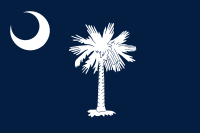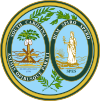Portal:South Carolina
The South Carolina Portal South Carolina (/ˌkærəˈlaɪnə/ KARR-ə-LY-nə) is a state in the coastal Southeastern region of the United States. It borders North Carolina to the north, the Atlantic Ocean to the southeast, and Georgia to the southwest across the Savannah River. Along with North Carolina, it makes up the Carolinas region of the East Coast. South Carolina is the 40th-largest and 23rd-most populous U.S. state with a recorded population of 5,118,425 according to the 2020 census. In , its GDP was $213.45 billion. South Carolina is composed of 46 counties. The capital is Columbia with a population of 136,632 in 2020; while its most populous city is Charleston with a 2020 population of 150,227. The Greenville-Spartanburg-Anderson, SC Combined Statistical Area is the most populous combined metropolitan area in the state, with an estimated 2023 population of 1,590,636. South Carolina was named in honor of King Charles I of England, who first formed the English colony, with Carolus being Latin for "Charles". In 1712 the Province of South Carolina was formed. One of the original Thirteen Colonies, South Carolina became a royal colony in 1719. During the American Revolutionary War, South Carolina was the site of major activity among the American colonies, with more than 200 battles and skirmishes fought within the state. South Carolina became the eighth state to ratify the U.S. Constitution on May 23, 1788. A slave state, it was the first state to vote in favor of secession from the Union on December 20, 1860. After the American Civil War, it was readmitted to the Union on July 9, 1868. During the early-to-mid 20th century, the state started to see economic progress as many textile mills and factories were built across the state. The civil rights movement of the mid-20th century helped end segregation and legal discrimination policies within the state. Economic diversification in South Carolina continued to pick up speed during and in the ensuing decades after World War II. In the early 21st century, South Carolina's economy is based on industries such as aerospace, agribusiness, automotive manufacturing, and tourism. (Full article...)
Entries here consist of Good and Featured articles, which meet a core set of high editorial standards.
 William Johnson Jr. (December 27, 1771 – August 4, 1834) was an American attorney, state legislator, and jurist who served as an Associate Justice of the Supreme Court of the United States from 1804 until his death in 1834. When he was 32 years old, Johnson was appointed to the Supreme Court by President Thomas Jefferson. He was the first Jeffersonian Republican member of the Court as well as the second Justice from the state of South Carolina. During his tenure, Johnson restored the act of delivering seriatim opinions. He wrote about half of the dissents during the Marshall Court, leading historians to nickname him the "first dissenter". Johnson wrote the majority opinion for two major cases (including United States v. Hudson) and hundreds of majority opinions in minor admiralty, land, and insurance cases. He supported a strong federal government in economic matters, leading him to join the majority in cases such as McCulloch v. Maryland, Gibbons v. Ogden, and Fletcher v. Peck to the dismay of Jefferson and other Republicans. (Full article...)Selected article -
From December 1876 to April 1877, the Republican and Democratic parties in South Carolina each claimed to be the legitimate government. Both parties declared that the other had lost the election and that they controlled the governorship, the state legislature, and most state offices. Each government debated and passed laws, raised militias, collected taxes, and conducted other business as if the other did not exist. After four months of contested government, Daniel Henry Chamberlain, who claimed the governorship as a Republican, conceded to Democrat Wade Hampton III on April 11, 1877. This came after President Rutherford Hayes withdrew federal troops from the South. (Full article...) General images -The following are images from various South Carolina-related articles on Wikipedia.
Did you know -
|
Topics
Categories
New articles
Rules | Match log | Results page (for watching) | Last updated: 2024-06-10 21:45 (UTC)
Note: The list display can now be customized by each user. See List display personalization for details.
- Kevin Schnall (edit | talk | history | links | watch | logs | tools) by Senoreida (talk · contribs · new pages (3)) started on 2024-06-10, score: 30
- John Vrooman (baseball coach) (edit | talk | history | links | watch | logs | tools) by Senoreida (talk · contribs · new pages (3)) started on 2024-06-09, score: 30
- South Carolina Workers Party (edit | talk | history | links | watch | logs | tools) by ProfessorKaiFlai (talk · contribs · new pages (1)) started on 2024-06-06, score: 20
- 1808 United States presidential election in Virginia (edit | talk | history | links | watch | logs | tools) by Memevietnam98 (talk · contribs · new pages (22)) started on 2024-06-05, score: 20
- Liatris pilosa (edit | talk | history | links | watch | logs | tools) by Abductive (talk · contribs · new pages (26)) started on 2024-06-04, score: 32
- 2024 South Carolina Gamecocks softball team (edit | talk | history | links | watch | logs | tools) by FlowersEaston (talk · contribs · new pages (2)) started on 2024-06-04, score: 28
- 2024 Cook Out Southern 500 (edit | talk | history | links | watch | logs | tools) by 45BearsFan (talk · contribs · new pages (7)) started on 2024-06-03, score: 20
- 2024 South Carolina Gamecocks baseball team (edit | talk | history | links | watch | logs | tools) by FlowersEaston (talk · contribs · new pages (2)) started on 2024-06-02, score: 21
- Yanyuan Ma (edit | talk | history | links | watch | logs | tools) by David Eppstein (talk · contribs · new pages (22)) started on 2024-06-02, score: 30
- Jensen Castle (edit | talk | history | links | watch | logs | tools) by Derlinus (talk · contribs · new pages (12)) started on 2024-06-02, score: 28
- Liatris gracilis (edit | talk | history | links | watch | logs | tools) by Abductive (talk · contribs · new pages (26)) started on 2024-06-02, score: 36
- Cedar Falls Park (edit | talk | history | links | watch | logs | tools) by John Foxe (talk · contribs · new pages (1)) started on 2024-06-01, score: 40
- Sam Blaskowski (edit | talk | history | links | watch | logs | tools) by Codyave (talk · contribs · new pages (2)) started on 2024-06-01, score: 20
- Cody Garrett (edit | talk | history | links | watch | logs | tools) by K00B8 (talk · contribs · new pages (7)) started on 2024-06-01, score: 40
- Bamberg County School District (edit | talk | history | links | watch | logs | tools) by WhisperToMe (talk · contribs · new pages (42)) started on 2024-05-31, score: 40
- LaDazhia Williams (edit | talk | history | links | watch | logs | tools) by Dmhll (talk · contribs · new pages (2)) started on 2024-05-31, score: 38
- Letitia H. Verdin (edit | talk | history | links | watch | logs | tools) by Philipnelson99 (talk · contribs · new pages (2)) started on 2024-05-30, score: 60
- Shem Creek (edit | talk | history | links | watch | logs | tools) by DMVHistorian (talk · contribs · new pages (4)) started on 2024-05-30, score: 40
- Brian L. Johnson (edit | talk | history | links | watch | logs | tools) by Smasongarrison (talk · contribs · new pages (113)) started on 2024-05-30, score: 40
- Hyman's Seafood (edit | talk | history | links | watch | logs | tools) by DMVHistorian (talk · contribs · new pages (4)) started on 2024-05-28, score: 40
- List of Alpha Epsilon Rho chapters (edit | talk | history | links | watch | logs | tools) by Rublamb (talk · contribs · new pages (19)) started on 2024-05-28, score: 22
Related portals
WikiProjects
Associated Wikimedia
The following Wikimedia Foundation sister projects provide more on this subject:
-
Commons
Free media repository -
Wikibooks
Free textbooks and manuals -
Wikidata
Free knowledge base -
Wikinews
Free-content news -
Wikiquote
Collection of quotations -
Wikisource
Free-content library -
Wikiversity
Free learning tools -
Wikivoyage
Free travel guide -
Wiktionary
Dictionary and thesaurus












































